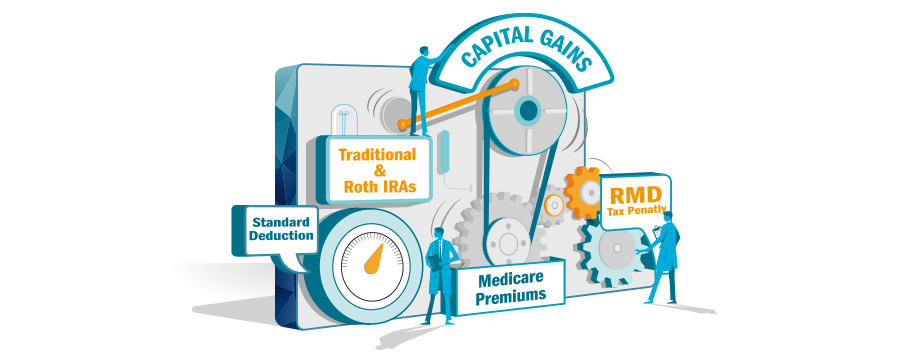11 tax deductions and credits to know
Reduce your tax liability by taking advantage of the different tax breaks that may be available to you.

When you maximize available tax deductions and credits each year, you help reduce your tax liability. The challenge is identifying the various opportunities that make sense for your personal circumstances — and strategically leveraging them for maximum impact.
Your Ameriprise financial advisor will work alongside your tax professional to help you utilize tax opportunities, including credits and deductions available to you.
Here are 11 credits and deductions by category:
In this article
| Tax deductions | Tax credits | |
| How it impacts your taxes | Reduces your taxable income, indirectly lowering your tax liability. | Directly reduces your tax liability, dollar-for-dollar. |
| How it works | You subtract specific eligible expenses you’ve incurred from your taxable income, reducing how much of your income is subject to taxes. | If you’re able to claim a tax credit valued at $1,000, for example, your tax bill be lowered by $1,000. |
| Types |
|
|
Investing credits and deductions
1. Traditional IRA and 401(k) contribution deductions
Contributions to traditional IRA accounts may be deductible. The amount you can deduct depends on your:
- Filing status
- Modified AGI
- Whether or not you’re covered by an employer’s retirement plan
With traditional 401(k) plans, contributions aren’t deductible, though they reduce taxable income for the year. Employers should automatically deduct your contributions from your taxable income on your pay stubs and W-2 forms.
Deduction type: To deduct IRA contributions, Schedule 1 of the 1040 must be filed. 401(k) contributions are above-the-line deductions and don’t require itemizing.
2. Capital loss deduction
When you sell a capital asset at a loss, you will report it on Schedule D, Capital Gains and Losses, with your individual tax return. To determine the deductibility of capital losses, you total all capital gains and losses, both long term and short term, incurred during the year. If gains exceed losses you have a net capital gain, which determines the capital gains tax you owe.
Capital losses are deductible only to the extent of capital gains, plus up to $3,000 of ordinary income. You can carry forward any additional losses to future tax years.
Deduction type: Above-the-line, doesn’t require itemizing.
3. Investment interest expense deduction
If you’ve taken out loans to purchase eligible investment properties, you may be able to write off the associated interest. The investment interest expense deduction allows you to deduct qualifying interest up to the amount of your net investment income for the year.
For example, if you use margin loans to buy stock in your brokerage account, you may be able to deduct the interest you’ve paid throughout the year on the loans, up to your net income from the associated stock.
Deduction type: Below-the-line, requires itemizing.
Health care credits and deductions
4. Medical expenses deduction
You can deduct your household’s (taxpayer, spouse, and dependents) qualifying unreimbursed medical and dental expenses once they exceed 7.5% of your adjusted gross income (AGI). Eligible expenses typically include payments for services that diagnose, cure, treat or prevent disease.
Deduction type: Below-the-line, requires itemizing.
5. HSA contribution deduction
Health savings accounts (HSAs) help eligible individuals save on out-of-pocket medical expenses with high-deductible health plans (HDHPs). If you qualify, you can make HSA contributions up to the limit each year and the contributions are either deductible or excluded from income. Distributions are tax-free as long as you spend the funds on qualified medical expenses.
Deduction type: Above-the-line, doesn’t require itemizing.
Business credits and deductions
6. Qualified business income deduction
Qualified business income (QBI) is the net gain, income, deduction and loss from a given tax year for a business. The QBI deduction allows eligible domestic sole proprietors, S corps, partnerships, trusts and estates to deduct up to 20% of their QBI. It also lets you deduct up to 20% of income from publicly traded partnerships (PTP) and 20% of dividends from qualified real estate investment trusts (REIT).
The total allowable deduction is capped at the lesser of 20% of your taxable income (minus your net capital gain) or the sum of the two QBI deduction components. It can also be limited by factors such as your business type, W-2 wages paid and taxable income. The calculation and qualifications for this deduction can be complicated, so please contact your tax professional for additional information.
Deduction type: Below-the-line, but doesn’t require itemizing.
7. Self-employment tax deductions
If you’re self-employed, you can generally deduct business expenses that are:
- Ordinary: An expense that is common and accepted in an industry
- Necessary: An expense that is helpful and required for the operation of a business
- Not specifically excluded: Nondeductible expenses include capital expenses, personal expenses and costs of goods sold
While business expense deductions are limited by your total annual income, you can also deduct 50% of the self-employment (SE) tax from your adjusted gross income. The SE tax rate is currently 15.3%, which includes 12.4% for Social Security and 2.9% for Medicare.
Deduction type: Above-the-line, doesn’t require itemizing.

Childcare credits and deductions
8. Child tax credit
The child tax credit offers parents a credit of $2,000 for each qualifying child under age 17 (determined as of the end of the tax year).
The credit is phased out by $50 for each $1,000 (or fraction) that modified adjusted gross income (MAGI) exceeds the applicable threshold amounts ($200,000, or $400,000 if married filing jointly).
You also need to meet other eligibility requirements. For example, the child has to live with you for more than half of the year.
Credit type: Non-refundable.
9. Child and dependent care credit
If you pay for work-related childcare for a dependent under age 13, you may qualify for the child and dependent care credit. Along with having a qualifying dependent, you need an AGI under the annual income limits to qualify.
Eligible individuals can claim up to $8,000 in work-related care expenses per qualifying dependent. The credits then go as high as 50% of the claimed expenses or $4,000, whichever is less.
Credit type: If there is any remaining child tax credit after the credit has been used to offset the taxpayer’s tax liability, the remaining amount may be refundable.
Other credits and deductions
10. Charitable donations deductions
If you donate cash, investments, or property to a qualified organization, you can deduct the amount on your taxes. The deduction is limited to a percentage of the taxpayer’s AGI determined by the type of organization receiving the donation and the type of property donated. That includes donations to all private operating foundations, all public charities and certain private foundations.
Deduction type: Below-the-line, requires itemizing.
Advice spotlight
Gifting appreciated stocks to a qualified organization may have an added tax benefit. In addition to the itemized deduction, you will not need to pay taxes on the gains of the stocks you donate to a qualified organization.
11. State and local tax deductions (SALT)
If you itemize deductions on IRS Form 1040, you can deduct some local and state non-business taxes. These may include foreign income tax, sales tax and personal property tax. The maximum deduction limit for individuals is $10,000, or $5,000 if you’re married and filing separately.
Deduction type: Below-the-line, requires itemizing.
When you’re ready to reach out to an Ameriprise financial advisor for a complimentary consultation, consider bringing these questions to your meeting.
Something went wrong. Do you want to try reloading? Try again
Or, request an appointment online to speak with an advisor.
At Ameriprise, the financial advice we give each of our clients is personalized, based on your goals and no one else's.
If you know someone who could benefit from a conversation, please refer me.
Background and qualification information is available at FINRA's BrokerCheck website.
 Return to My Accounts
Return to My Accounts



